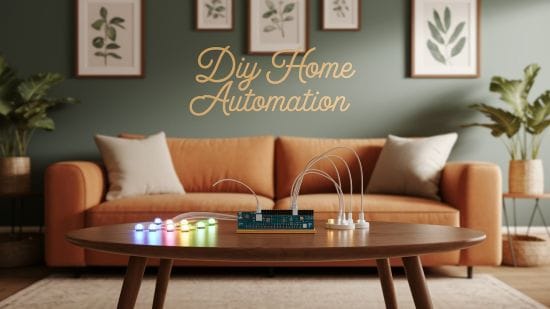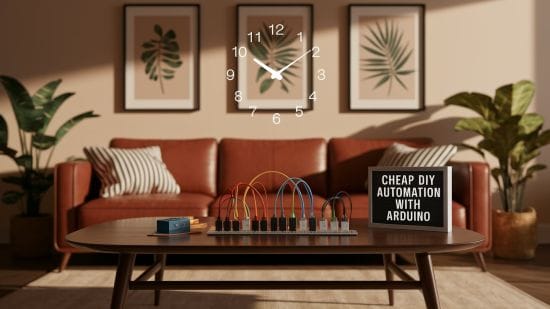The advancements in smart technology are making home automation systems increasingly popular as they allow users to manage and operate home appliances such as lights, fans, and even the security systems using a single device or a smartphone.
Many of the commercially available home automation systems are expensive and also require a professional to set them up for you. If you are looking to put together your own home automation system, Arduino allows you to do just that with their cost efficient DIY approach. In this guide we will explain the steps on how to create affordabe home automation with Arduino.
If you’re facing network issues on Windows XP VirtualBox VM check out our guide to fix it. For email migration from Lotus Notes to Outlook without data loss see our Lotus Notes vs Outlook migration tips. If you’re looking for a tablet for seniors consider the best tablet for elderly with large fonts and easy apps to make tech easier.
What is Arduino?
Arduino is an example of an open-source electronics platform. It comprises both hardware and software. They arduino boards are very user-friendly and can be used to operate a plethora of devices such as lights, motors, and even sensors.
With Arduino, automating simple or intricate tasks becomes more economical. With arduino, automated devices can be controlled according to sensor inputs, which is highly beneficial for home automation projects.
For teachers looking to enhance offline learning explore the best quiz apps for offline classrooms. If you’re into DIY projects try our guide on how to build your own smart mirror with Raspberry Pi. Finally if privacy is your concern learn how to self-host Bitwarden alternatives for better control.
Why Choose Arduino for Home Automation
Affordable Solution
One of the greatest advantages of Arduino is that it is cost effective. Commercially available home automation systems tend to be costly. With Arduino, you can implement inexpensive approaches to a home automation system. The Arduino board is reasonably priced, and so are the required sensors and relays.
Simple to Master
One reason people prefer Arduino is because of how simple it is to use. The software for programming the board is user friendly and no advanced computer science skills are necessary. There are numerous tutorials online that make learning how to use Arduino simple. For beginners in electronics, starting with Arduino is recommended.
Customizable and Open Source
Being an open-source project, everyone has free rein to make alterations as deemed fit to Arduino’s hardware or software designs. This allows customization of home automation systems like lights, fans, and security, tailoring them to suit specific requirements.
Do It Yourself Budget-Friendly Home Automation
When embarking on a new home automation project, a few primary components are imperative first. This is a list that contains the most important things for your Arduino-based home automation system.

Components Required
- Arduino Board: The most common boards are Arduino Uno and Arduino Nano.
- Relay Module: This module is used to control high-voltage devices like lights and fans.
- Sensors: You can use motion sensors temperature sensors and light sensors.
- Wi-Fi Module: If you want to control your system remotely use a Wi-Fi module like ESP8266.
- Power Supply: Make sure to have the correct power supply for your devices and Arduino board.
Once you have these components you can begin assembling your system.
Setting Up Arduino
The first step in creating a home automated system is configuring the Arduino board. This includes plugging the Arduino board into the computer via a USB connection. Following this, you have to download the Arduino IDE which is available on their official page. The software in question enables you upload code to your Arduino board.
A Guide on Unit Connections
Now that all the components are connected to the appropriate software, you must connect each component to the Arduino board. Due to the fact that there are different types of hardware available, the projects might differ in the wiring patterns.
For instance, with light control projects, you have to add a relay onto the digital pins of the Arduino board. Furthermore, speres to be utilized should be plugged to the input pins of rhe board. Remember to use the jumpers for the target connections.
Arduino Coding
With hardware set up in place, you need to program how the Arduino should respond to stimuli through coding. For ease of use, Arduino provides users with a simplified programming language. The programming language enables you to define how the sensors retrieve data while command functionalities such as motors, lights, or alarms receive control commands.

Example Code for Motion Detection
Here is a simple code example that uses a motion sensor to turn an LED on and off. When the sensor detects motion the LED turns on. When there is no motion the LED turns off.
cppCopyEditint motionSensor = 2;
int led = 13;
void setup() {
pinMode(motionSensor, INPUT);
pinMode(led, OUTPUT);
}
void loop() {
int motion = digitalRead(motionSensor);
if (motion == HIGH) {
digitalWrite(led, HIGH);
} else {
digitalWrite(led, LOW);
}
}
Upload the code to your Arduino board using the Arduino IDE. Now your Arduino will be able to detect motion and control the LED accordingly.
Cheap DIY Home Automation Projects
Once you understand the basics of Arduino it is time to start building your own DIY home automation projects. Below are some simple and affordable projects that you can build with Arduino.
1. Smart Light Control
Using a motion sensor you can control lights automatically. The lights will turn on when motion is detected and turn off when no motion is detected. This can save energy and make your home more convenient.
Components Needed:
- Arduino board
- PIR motion sensor
- Relay module
- Light bulb
- Jumper wires
2. Automated Plant Watering System
This project uses a soil moisture sensor and a water pump to automatically water your plants. When the soil becomes dry the system will activate the pump and water the plant. This is perfect for people who forget to water their plants.
Components Needed:
- Arduino board
- Soil moisture sensor
- Relay module
- Water pump
- Jumper wires
3. Smart Thermostat
With a temperature sensor and a fan or heater you can build a smart thermostat. The thermostat will adjust the temperature in your home based on the readings from the sensor. This can help save energy and keep your home comfortable.
Components Needed:
- Arduino board
- DHT22 temperature sensor
- Relay module
- Fan or heater
- Jumper wires
4. Smart Door Lock
You can build a smart door lock with Arduino using an RFID reader and a servo motor. When the correct RFID tag is scanned the servo motor will unlock the door. This is a great way to secure your home.
Components Needed:
- Arduino board
- RFID reader
- RFID tags
- Servo motor
- Jumper wires
5. Home Security System
Using motion sensors and a buzzer you can build a simple home security system. When motion is detected the system will trigger an alarm. This will alert you to any intruders or movement in your home.
Components Needed:
- Arduino board
- PIR motion sensors
- Buzzer
- Jumper wires
Pros and Cons of DIY Home Automation with Arduino
| Pros | Cons |
|---|---|
| Affordable and low-cost | Requires basic knowledge of electronics |
| Easy to customize | May require trial and error |
| Large online community for support | Some sensors may not be reliable |
| Open-source platform | Time-consuming to set up and troubleshoot |
| Great for learning electronics | Limited range for remote control |
Frequently Asked Questions
1. How do I get started with Arduino?
Start by getting an Arduino board and essential components. Download the Arduino IDE and follow online tutorials to begin programming your board.
2. Can I control my home automation system with my smartphone?
Yes. By adding a Wi-Fi module like ESP8266 or ESP32 you can control your system from your smartphone using a web interface or mobile app.
3. How much does it cost to build a DIY home automation system?
The cost depends on the project and the components used. A simple project can cost around $20 to $50.
4. Do I need to know programming to use Arduino?
It helps to know some basic programming but many tutorials and example codes are available to help you get started.
5. Is Arduino suitable for large-scale home automation projects?
Arduino is great for small to medium projects. For large-scale home automation you might need more powerful systems like Raspberry Pi or commercial solutions.
Conclusion
Cheap DIY home automation with Arduino is an affordable and fun way to make your home smarter. With Arduino you can automate lights fans security systems and more. It is an excellent choice for people who want to build their own home automation systems without spending a lot of money. Start with simple projects and gradually add more complexity as you learn. Arduino makes home automation accessible to everyone.